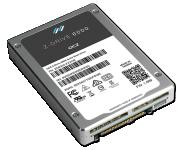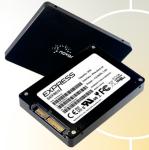|
|
|
| ..... |
|
 |
|
| ..... |
|
|
|
|
| ..... |
|
|
|
|
| ..... |
|
"My guess is
that
1 in 4 fast enterprise 2.5" SSDs
will be PCIe rather than SAS
in 3 years time."
comment - re SAS SSD market cannibalization
(September 2012) | |
by Zsolt
Kerekes, editor, StorageSearch.com
- May 21, 2012
A new family is planning to move into the
enterprise end of SSD
street - removable 2.5" SSDs which have a PCIe interface.
The
market for 2.5" SSDs which have a PCIe interface marks the soon to be
crowded intersection point of 3 different SSD market strands.
- the next step in the SATA-IO (ORG) performance roadmap for
SATA 3 SSDs in the
form of SATA express (with 2 lanes of gen2 PCIe) instead of a 12Gbps scaling of
Serial ATA - which
option was rejected in
2011 as
not offering a competitively viable standard.
- an alternative upwards (or sideways migration route) for systems designers
who need a next step after 12Gbps
SAS SSDs.
- a virgin market opportunity for vendors who already have IP assets in the
crowded enterprise PCIe
SSD market and who want to stretch those assets into new application areas
for removable PCIe SSDs.
One way to think about the scale of the market
opportunity is this.
Suppose you're in the controller business and
already have a PCIe SSD IP which sells well in enterprise server slots.
In
classical SAN
architecture - for every SSD you sell which plugs into a server slot -
there's a lot more drive slots out there in the storage racks.
OK the
reality is that - in competition with the SAN view of the enterprise - we now
also have the scalable storage as software - or
cloud types of
architecture too.
But whatever may happen in the end - the thing
which will undoubtedly happen next - is that the number of potential SSD
slots in SAN storage racks is a bigger number (10x) and will grow faster
than the SSD slots in new servers. The only complicating factors which
are going to slow down the race to get products into the 2.5" PCIe SSD
market are detailed marketing decisions about whether to ship vanilla SSDs or
use the new form factor as a way to leverage new features which users will
specifically value or expect too see in this particular module form factor -
due to the cultural heritage and experience with earlier types of 2.5"
SSDs. They relate to:-
- SSD software:-
the specific type of virtuualization. The 2.5" paradigm supports hot swap
and upgrades. Ideally the software should support almost instant benefits if
users decide to plug in new 2.5" SSDs.
- standards: - what
language will the 2.5" PCIe SSDs speak? PCIe is a neutral physical
connection. The emerging SCSI Express standard is just one of many
possibilities. Others include standard storage networks such as
SAN,
iSCSI etc.
- fault
tolerance:- what type of architecture will underpin the 2.5" PCIe SSD
rack? Possibilities range from standard
RAID like systems upto
proprietary schemes which can provide much better resilience at greater
efficiency.
- pricing strategy:-
the new form factor will open up new application slots - some of which will be
positioned above those of existing 2.5" SAS SSDs. But less obviously by
negating the essential need for on-board controllers some of the new SSDs
could be positioned in the cost gap between high end enterprise SATA SSDs
and fast-enough SAS SSDs too (see more below).
How will the 2.5" PCIe SSD market affect the business of current
PCIe SSD companies?
I've spoken to a representative sample of
enterprise SSD companies about the new form factor. This includes companies
which currently make PCIe SSDs and also some who don't.
The general
view is that 2.5" PCIe SSDs represent additional new business - compared to
installing PCIe SSD cards and multi-card modules into server slots.
How
will 2.5" PCIe SSDs impact the business of SAS SSD makers?
In
the long term I think it will reduce the market size for SAS SSDs because the
new types of SSDs will provide faster throughput and lower latency - and the
possibility of offering fast-enough SSDs at lower cost too.
However SAS
SSDs work here and now - and it could take another year or so for 2.5" PCIe
SSDs to get firmly established in the market.
My guess is that
initially some vendors of 2.5" PCIe SSDs will position their products as
options which sit above the performance capabilities of their SAS SSD product
lines.
But other options are possible too. For example a 2.5" PCIe
SSD - which offloads its flash controller functions to the host server (like
Fusion-io's products)
could deliver lower power consumption and higher capacity than traditional SAS
SSDs - and at lower cost. In the non-offfloaded flash management design (which
other vendors may also introduce too) - the new 2.5" PCIe SSDs could be
designed at a lower cost than SAS SSDs (because they don't need the controller).
That's one of the reasons that SAS SSD makers are looking at this
market too.
Why do we need yet another type of SSD component in the
enterprise?
The simple answer is that some users prefer the unit of
upgrade or fault replacement to be a drive instead of a whole rack.
And
although it's possible to upgrade or replace PCIe SSDs at the card level - it's
more convenient to do so at the module level.
The new 2.5" PCIe
SSDs will affect the variety of options seen inside fast SSD racks. They have
been a long time coming and are already included in my earlier published models
about SSD market silos.
As I said above - there will soon be more than
20 companies in this market - and the new products will be the showcases for
new configuation possibilities.
Companies which have already publicly
announced such products and demonstrated prototypes, or are shipping them
include:-
OCZ,
Micron,
Fusion-io and
Samsung.
2.5" footprint enables higher performance density than
traditional slots
In March 2014 a reader designing large scale high
performance systems told me that one attraction of 2.5" PCIe SSDs was
packing density and performance compared to traditional HHHL modules.
Based
on analyzing anticipated products he said - "Replacing one HHHL card
with two SFF SSDs you consume the same physical volume, get the same capacity
but have twice the power budget and can get almost twice the bandwidth."
...Update:- September 2012
The subject of 2.5"
PCIe SSDs and related standards such as NVMe came up in several papers and blogs
centered on the Flash Memory Summit
(August 2012).
Here are some links and notes.
- "2 competing enterprise initiatives have emerged in the attempt to
align the industry around PCIe based SSDs - SCSI express (led by HP) and NVMe
(led by Intel and Dell). While a 3rd standard - SATA express - is aimed at
clients and hybrids. In the 2.5" drive size - a multi-function bay can
support both SAS and PCIe SSDs with the same SFF-8639 connector" -
HGST
paper - enterprise interface trends (pdf)
| |
..... |
| ..... |
|
|
|
|
| ..... |
|
|
|
|
| ..... |
|
|

|
| |
| Now Cinderella embedded
systems with low cost budgets and low wattage footprints can go to the
enterprise NVMe performance ball.
|
| SSD news - (April
19, 2017) | | |
| .. |
| SanDisk
announces the late arrival of its 2.5" NVMe SSD |
Editor:- February 10, 2017 - SanDisk recently
recycled the "Skyhawk" SSD brand - which had previously been
associated with a rackmount
SSD product (launched in
October 2014)
from Skyera -
another SSD company - like SanDisk - which was
acquired by
Western Digital and by coincidence whose founder's new company emerged from
stealth this week. (See the story about Tachyum in
SSD news.)
The
new SanDisk
Skyhawk
is aimed at the 2.5"
NVMe PCIe SSD market.
Although
SSD brand names can
be important the significant thing about SanDisk's new Skyhawk is that it
fixes a longstanding strategic weakness in its enterprise PCIe SSD product
line which I commented on in
October 2015
(when WD announced it would acquire SanDisk).
The irony is that
Fusion-io (which
created the enterprise
PCIe SSD market and by whose acquisition SanDisk hoped in
June 2014 to
broaden its flash presence in the enterprise market) had been one of the
earliest companies to demonstrate a prototype 2.5" PCIe SSD (in
May 2012). But
Fusion didn't productize that concept and chose instead to move upscale in form
factor to boxes.
Decoupling from the complex legacy of the past is
why it has taken nearly 5 years for SanDisk to
launch
its me too Skyhawk 2.5" NVMe SSD now. | | |
| .. |
|
| .. |
| Foremay
ships aerospace 8TB 2.5" U.2 NVMe SSD |
Editor:- September 26, 2016 - Foremay today
announced
volume production of 8TB models in its rugged secure 2.5" U.2 NVMe SSD
product range - which with PCIe x4 lanes has R/W speeds up to 1.2GB/s with
latency as little as 25 microseconds. Optional features include:-
- Military secure erase and fast erase features.
- Rugged designs with anti-shock and anti-vibration, meeting MIL-STD-810G/F
standards.
- Anti-radiation and anti-emission, both electrical and magnetic, for
aerospace applications subject to the customer's specifications.
| | |
| ..... |
| Liqid
controller inside fastest 2.5" NVMe flash SSD |
| Editor:- August 9, 2016 - In a joint
press
release today Liqid
and Kingston
gave details of the "fastest 2.5" PCIe NVMe flash SSD ever
benchmarked" - which they're showing this week at FMS. | | |
| ... |
|
|
| ... |
| Micron acquires stealth
mode NVMe SSD controller company - Tidal Systems |
| Editor:- October 3, 2015 - Micron has acquired
Tidal Systems (a stealth mode
controller company whose home page has the statement "Enabling PCIe NVMe
Flash Storage Development". | | |
| ... |
| Seagate enters 2.5"
NVMe SSD market |
| Editor:- August 11, 2015 - Seagate today
announced
details of 2 new families of
NVMe SSDs which
will be available in 2.5"
(October) and M.2 (in early
2016) form factors. | | |
| ... |
| OCZ's new 3TB 2.5" hot
swap NVMe SSDs |
 Editor:-
May 20, 2015 - OCZ
today revealed more details about the new models shipping in its NVMe
compatible PCIe SSD family - which was first announced last
September. We
had already heard before these new models include 2.5" hot swappable
versions. Editor:-
May 20, 2015 - OCZ
today revealed more details about the new models shipping in its NVMe
compatible PCIe SSD family - which was first announced last
September. We
had already heard before these new models include 2.5" hot swappable
versions.
Today OCZ said this model - the
Z-Drive 6300 SFF
will be available with usable capacities of 800GB, 1.6TB and 3.2TB (in
this quarter) followed by 6.4TB (later this year).
R/W
performance is upto 2.9GB/s and 1.4GB/s respectively. Random R/W
IOPS are
700K IOPS and 120K IOPS. Latencies are 30s (write) and 80s (read).
Endurance
options are 1 or 3 DWPD.
high
availability and reliability features
The new Z-Drive 6000 models
are dual ported so that 2 host systems can concurrently access the same SSD.
Additionally, the Z-Drive 6000 Series supports hot swapping of 2.5"
drives, pre-set power thresholds and temperature throttling to support many
types of enterprise ecosystems.
Editor's comments:- for various reasons to do with a
combination of standardization
efforts and changes
of ownership for nearly every major enterprise PCIe SSD company in the
market - you've had to wait 3 years since the idea of this kind of product was
first discussed seriously on
these pages and at
conferences.
What has become clear to systems architects is that these
new products offer far more flexibility in their roles than merely performance
upgrades to high end SAS
SSDs and traditional storage arrays.
Among other things these new
types of products will enable lower cost mini SSD server clustering at
PCIe latencies which will spur growth in the SDS market. At the high end - they
could become the new building blocks inside the world's most powerful computer
arrays.
Power consumption and heat in these NVMe SSDs?
I
know from talking to systems architects that the electrical power and thermal
footprints of 2.5" NVMe SSDs is a critical detail when considering the
design of dense storage arrays so I asked Scott Harlin,
OCZ for more information these factors. Here's what Scott said.
Hi
Zsolt you are correct the 2.5 drives can get a little toasty packing in the
higher densities into this form factor -- typical power consumption of the
Z-Drive 6000 series is 25W active and 9W idle. So we included a few items to
address these concerns:
1. - Temperature sensing and thermal throttling to maintain
consistent operating conditions even under adverse temperature variances
2. - User-selectable power envelopes, in 15W, 20W and 25W
settings, reduces wasted power when maximum performance is not required while
efficiently addressing temperature requirements in support of a variety of
ecosystems
3. - An innovative flow-through case design enables more airflow
to critical components, keeping the device cool while reducing airflow
requirements
Editor's comments:- that user selectable power envelope- in graduated
steps - seems like a really useful design attribute. So I'll be watching out
for it in future arrayable SSD launches. | | |
| ... |
|
Memblaze enters 2.5" PCIe SSD market |
Editor:- March 16, 2015 - Memblaze today
announced
it is showing a 2.5"
NVMe PCIe SSD variant of its PBlaze series at
CeBIT in Germany.
Memblaze was the
27th most highly searched SSD company by readers of StorageSearch.com in
Q4 2014. | | |
| ... |
|
|
| ... |
| 8TB 2.5" PCIe SSDs
sampling soon from Novachips |
Editor:- March 4, 2015 - Are you interested in a
world's first 2.5"
8TB (15mm height) PCIe Gen2 x4 SSD (pdf) with a single controller
developed by Novachips.
in Korea?
 That
was an email I got recently from Sean Oh, based in
Kronberg, Germany, (eukotech@gmx.de) who is the sales representative for
these products in Europe. That
was an email I got recently from Sean Oh, based in
Kronberg, Germany, (eukotech@gmx.de) who is the sales representative for
these products in Europe.
What would you say? I did the same. After
reading up the info he attached (there's a
SATA version
too) I asked some questions about availability. Here's what Sean said.
- The working engineering samples have been available since last year.
- The 1st customer sample comes out in the next 30 days.
- We plan to start a mass production in 2nd half of this year.
Editor's comments:- part of this story has its roots in a news
story from May 2007
- when a company called MOSAID was talking about a new, light capacitive load,
ring based, flash memory topology called HLNAND. To make it work they needed a
controller. Novachips collaborated on the design and recently acquired the
assets and patents. | | |
| ... |
| OCZ samples hot swap,
fast 2.5" NVMe SSDs |
Editor:- September 9, 2014 - OCZ
announced
that this month it will begin sampling a new
2.5" hot
swappable enterprise PCIe SSD - the Z-Drive 6000 - a native PCIe 3.0
NVMe 1.1 solution - which the company says "provides industry-leading
IOPS per dollar".
It has a SFF-8639 connector, internal
RAID,
power loss
data protection, "consistent low
latency", and encryption.
Editor's comments:- Although
OCZ demonstrated the SSD industry's first working 3.5" PCIe SSD
prototype 4 years ago - in
August 2010 - the
company didn't follow through to establish an early lead in its natural
successor - the 2.5" enterprise PCIe market.
The main reason for
that being financial problems in OCZ in the years which immediately
followed - which mitigated against products which didn't have a short term
guaranteed market.
Now, however, with OCZ having been almost a year
as a Toshiba group company - the small form factor enterprise NVMe market
looks like a natural fit for OCZ - as an extension of its long running
conventional form factor PCIe SSD accelerator business. | | |
| ... |
| Intel's new 2.5" PCIe
SSDs |
| Editor:- June 3, 2014 -
Intel has announced
details of new NVMe compatible
2.5" PCIe SSDs
- the
P3700
Series - which will offer upto 2TB (20nm) capacity in a 15mm high hot-swap
form factor. | | |
| .. |
|
|
| . |
|
|
| . |
|
|
| . |
|
|
| . |
|
| |
